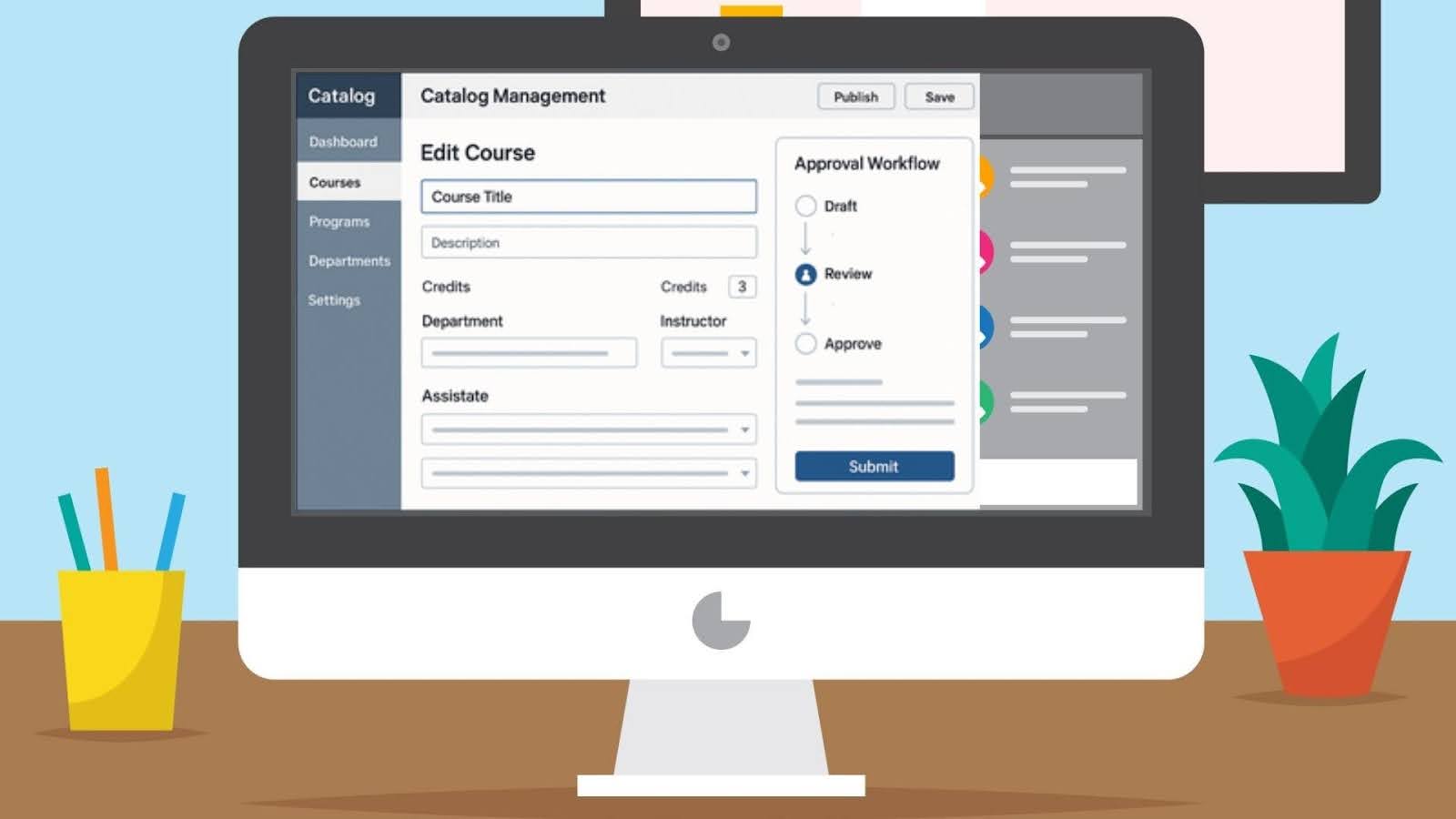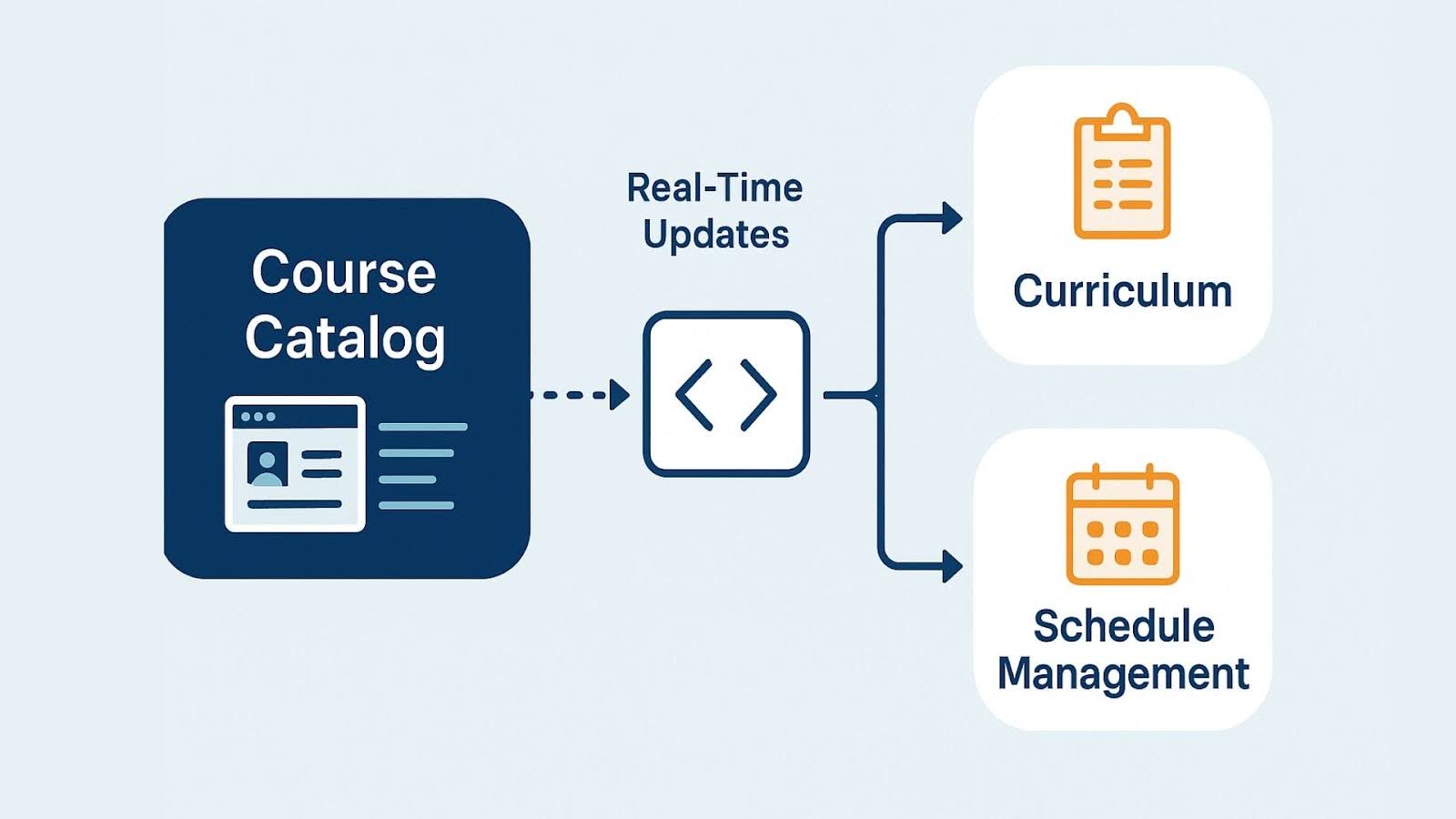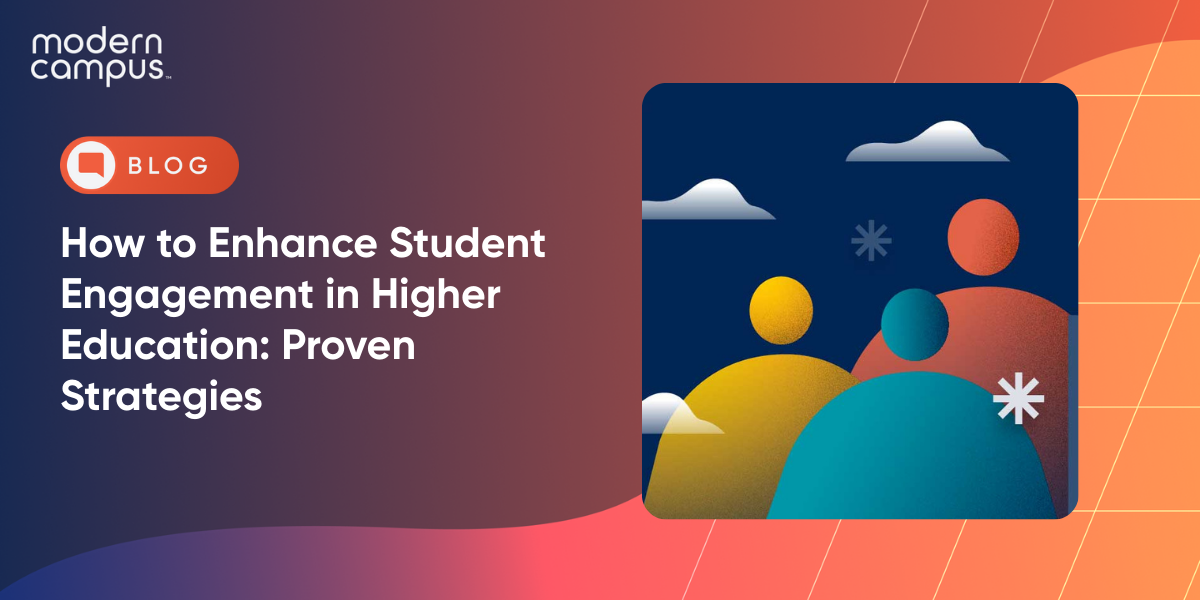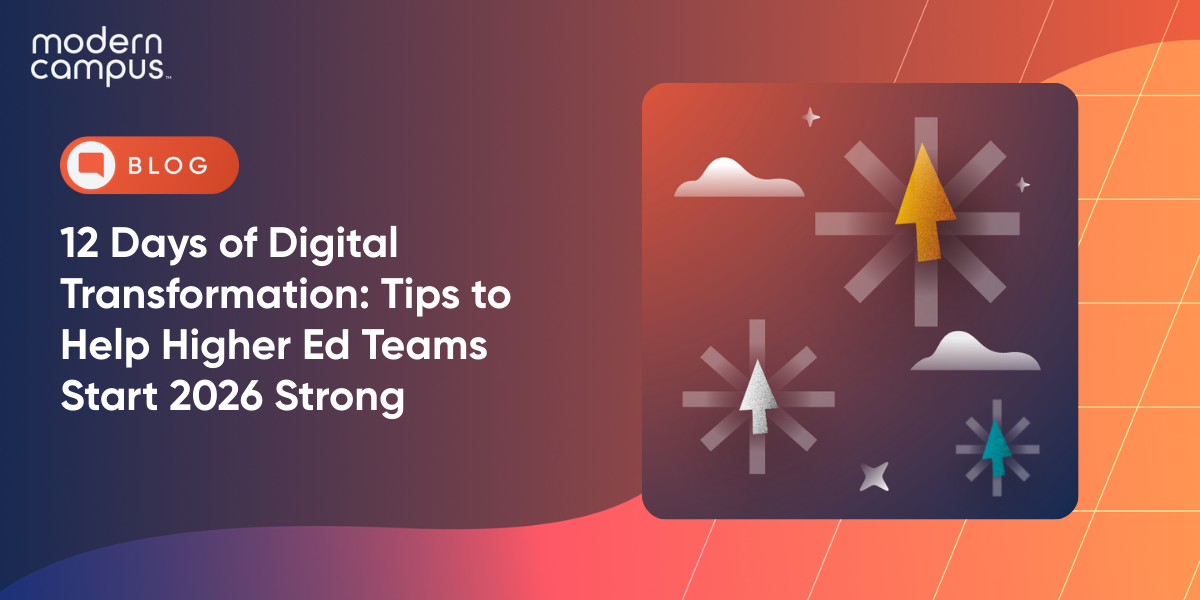7 Essential Higher Ed Course Catalog Software Features that Enhance Student Engagement and Success
Creating an engaging student journey starts with discovery. Prospective students expect immediate, user-friendly access to program information that reflects both the quality of education and the relevance of outcomes. Research indicates that students now consider digital experiences a significant factor in their enrollment decisions. For institutions facing enrollment cliffs, shifting learner demographics and rising competition, a streamlined, modern catalog is a key driver of engagement, retention and enrollment growth.
The most forward-thinking institutions are investing in higher ed course catalog software features designed to meet modern expectations. The right catalog management systems combine powerful back-end tools with intuitive, student-facing functionality to simplify the discovery process and empower learners to take control of their academic path. From dynamic filters and interactive elements to seamless curriculum integration, these platforms offer the digital experience students demand while saving staff valuable time behind the scenes.
Feature #1. Course Catalog Software: The Digital Front Door to Student Success
As students explore their academic options, their first meaningful interaction with your institution often happens through your course catalog. However, learners expect more than static PDF catalogs or outdated listings. They’re looking for streamlined, personalized and mobile-friendly experiences that reflect the flexibility and relevance of your programs.
An effective course catalog software solution helps institutions by transforming catalogs into dynamic, digital gateways that foster engagement from the start. With intuitive navigation, rich search capabilities and clear program information, students can easily explore paths aligned with their goals.
What Students Are Looking For
Modern learners are evaluating value. They want to understand how a course fits into their academic trajectory, what outcomes it supports and whether it aligns with career goals. When catalogs fail to deliver this information clearly, students lose trust or interest.
By using a powerful catalog management system, institutions can ensure that academic offerings are presented clearly and compellingly. When students can find the right course at the right time, the result is improved enrollment decisions, fewer administrative inquiries and a smoother onboarding process.
Key Benefits for Enrollment and Retention
Course catalog software actively enhances the student experience. Interactive catalogs with features like advanced search filters, personalized pathways and real-time updates eliminate confusion and increase student confidence in their decisions. These tools are especially critical during the exploration and registration phases, where clear, accurate and engaging catalogs can reduce melt and drive persistence.
From the institution’s perspective, digital catalogs reduce the time-consuming burden of manual updates, inconsistent formats and outdated PDFs. Instead of piecing together program information from multiple files and systems, staff can work from a single platform, saving valuable time while improving the consistency and professionalism of your offerings.
Feature #2. Streamlined Catalog Management for Speed and Accuracy
Behind every polished, student-facing catalog is a complex process of coordination, editing and approval. When that process relies on spreadsheets, email chains or static documents, it quickly becomes inefficient, and errors slip through the cracks. Streamlining the catalog management process maintains accuracy and agility in academic environments.
With robust catalog management software, institutions can reduce friction at every stage of catalog creation, from drafting new program details to securing approvals and publishing updates in real time. These platforms allow you to manage your catalog with fewer bottlenecks and more confidence, ensuring students always have access to the most accurate and relevant information.

Reduce Bottlenecks in the Catalog Production Process
Many institutions spend months producing print catalogs or wrangling disconnected files for web publication. These time-consuming processes drain resources and delay critical updates. By automating workflows and integrating directly with your curriculum management systems, a modern catalog tool dramatically cuts production timelines.
Instead of waiting on email approvals or manually formatting documents, staff can collaborate within a centralized platform, reducing miscommunication and saving valuable time. You gain a more agile team and a catalog that can evolve alongside your academic offerings without the lag.
Empower Staff with Easy-to-Use Catalog Maker Tools
One of the hallmarks of the best catalog software is ease of use. Even non-technical staff should be able to contribute to catalog updates without facing a steep learning curve.
Drag-and-drop editors, version control and access permissions make it easier to assign tasks, track progress and avoid errors.
By investing in user-friendly catalog maker features, your institution improves catalog accuracy and boosts staff morale. When teams can focus on content strategy and student needs rather than formatting issues or manual uploads, they become active partners in driving student engagement and institutional success.
Feature #3. Customizable Catalog Templates that Reflect Your Brand
Your catalog is a marketing tool. The design, tone and structure of your catalog say just as much about your institution as the courses themselves. Whether viewed on a mobile device or desktop, students expect branded, polished and easy-to-navigate catalogs.
Customizable catalog templates let institutions control how program information is displayed, making it easier to reflect school identity while maintaining consistency across departments. With a better user experience for students and a more professional presence, you're building trust from the first click.
Visual Appeal Meets Functionality
A beautifully designed catalog keeps students engaged. Clean layouts, color-coded categories, and embedded multimedia can turn passive browsing into active exploration. When students feel invited to interact with your offerings, they’re more likely to stay longer, explore further and convert from curious visitors into applicants.
Using pre-designed templates and interactive features, like flipbooks, tabbed browsing or video embeds, institutions can reduce bounce rates and increase page views. With the right platform, it's easy to balance aesthetics and usability while maintaining control over layout and content.
Consistency Across Programs and Departments
One of the biggest challenges in catalog management is maintaining consistency. Disparate formatting and inconsistent tone can frustrate students and make the catalog feel disjointed.
With centralized, template-driven catalog creation, your team can maintain formatting standards across every section regardless of who’s inputting the content. When every course and program listing aligns with your institution’s brand and values, your catalog creator software minimizes errors and redundancies.
Feature #4. Built-In Curriculum and Schedule Integration
Understanding how individual courses fit into the bigger picture of a degree pathway can be overwhelming, especially when information lives in different places. Institutions that connect their catalogs with curriculum and scheduling data empower students to make more informed decisions with less frustration.
Integrated catalog management systems allow real-time updates to course details, availability and prerequisites, ensuring students always have the most accurate and complete view. Integration simplifies internal coordination for staff, making it easier to align catalog updates with curriculum changes and scheduling logistics.

Real-Time Updates Improve Student Confidence
If students enroll based on information that turns out to be incorrect or incomplete, the experience can feel disjointed, sometimes enough to cause melt or drop-off. A catalog connected to your course scheduling and curriculum systems enables real-time syncing of changes, keeping data current across all platforms.
Whether it’s a course name update, a new instructor assignment or a change in availability, students immediately see accurate information. Transparency builds student confidence and supports stronger academic planning and persistence.
Align Course Data with Broader Catalog Creation Workflows
From initial program proposal to public catalog listing, academic offerings go through multiple review stages. Without the right infrastructure, this workflow becomes chaotic. An integrated catalog solution supports the entire lifecycle, linking data from the curriculum approval process all the way to publishing in your online catalog.
By bringing curriculum management and catalog production under one umbrella, institutions avoid version control issues, minimize manual data entry and save valuable time across departments. It’s a win-win for students and staff and a major step toward a more connected, efficient catalog strategy.
Feature #5. Personalization and Search Features that Put Students in Control
A catalog built for students means intelligent filters, personalized recommendations and interfaces that help them zero in on what matters most to their goals. Your catalog should act more like a smart assistant than a static archive. With the right catalog software, institutions can give students powerful tools to explore offerings based on interests, schedules and career paths.
Help Students Filter, Compare and Plan with Ease
Interactive features like keyword search, multi-faceted filters and side-by-side comparisons allow students to quickly identify programs and courses that match their interests. Whether they’re looking for hybrid classes, night schedules or subject-specific certificates, the best software makes those paths easy to find.
Students benefit from less guesswork and more clarity, while institutions benefit from fewer general inquiries and improved course matching. These interactive catalogs turn course exploration into a meaningful planning experience, especially when paired with features like suggested pathways or saved course lists.
Use Data to Surface Relevant Learning Pathways
When your platform can suggest programs based on previous interactions, popular searches or career goals, students feel seen and supported. Some catalog platforms integrate with career exploration tools, aligning offerings with job market trends and salary insights.
Customization helps guide undecided students, keeps returning learners on track and supports higher retention. By using engagement data to inform catalog presentation, institutions can meet students with the right message at the right time before they ever speak to an advisor.
Feature #6. Advanced Features that Support Career-Aligned Decision-Making
A modern catalog should inspire students to envision where courses can take them. As more learners pursue education with specific career goals in mind, institutions that offer career-aligned browsing experiences stand out.
By embedding tools like career outcome insights, salary data and persona-based pathways, catalogs become instrumental in student decision-making. While improving student engagement, your institution reinforces its commitment to supporting the full learner-to-earner journey.
Connect Catalogs with Real-Time Labor Market Insights
Integrating job market data into your catalog can provide powerful context for students weighing their options. When learners can see that a particular certificate aligns with a growing career field or that a certain degree path leads to high earning potential, they’re more likely to commit.
Some catalog management systems allow institutions to embed salary projections, growth outlooks and regional demand data directly within program listings. This turns your online catalog into a decision-making tool, helping students align their academic investments with tangible outcomes.
Use Personas and Outcomes to Guide Student Choices
While up to 50% of freshmen enter college without a career in mind, about 75% of all students end up changing their major at some point during their journey. Persona-driven navigation is a valuable catalog feature. By helping students explore paths based on interests or career goals (e.g., “future entrepreneur” or “community health advocate”), institutions can guide browsing in a way that feels approachable and tailored.
Interactive tools that let students explore outcomes, see example career paths or identify recommended program bundles turn exploration into action. These interactive features create a sense of clarity and motivation, especially for undecided or non-traditional students looking for direction and relevance.
Feature #7. Cloud-Based, Always-On Access from Any Device
Students manage their lives across multiple devices, switching between mobile, tablet and desktop as they balance work, life and school. If your catalog isn’t accessible or optimized for this reality, you risk losing prospective students before they ever apply. A cloud-based solution ensures that your catalog is available 24/7 and performs seamlessly across platforms and screen sizes.

Meet Students Where They Are—Literally
A responsive, mobile-friendly design allows students to interact with your catalog no matter where they are, offering consistent functionality and design. This is especially important for continuing education and non-traditional students who often rely on mobile devices as their primary tool for researching and enrolling in courses.
Cloud hosting also reduces downtime and enables your team to publish updates quickly, keeping your catalog accurate without interrupting the student experience. Students benefit from reliable access to course details, schedules and requirements exactly when they need them.
Support Mobile Use for Continuing and Non-Traditional Learners
Non-traditional learners who may be juggling full-time jobs, family obligations or other responsibilities rely on accessible, always-on resources. A cloud-based catalog gives these students the flexibility to explore programs, check course descriptions and plan learning pathways outside of traditional hours.
Many cloud platforms offer features like downloadable PDF catalogs or access to course data in formats like CSV files to meet student needs. With mobile-first design and always-on infrastructure, you’re building a catalog that expands access to education.
Start Building a Smarter Catalog
Your catalog is a strategic tool for student engagement, retention and long-term success. When students can easily find relevant information, connect academic offerings to career outcomes and navigate their options with confidence, they’re more likely to enroll, persist and thrive.
That’s why we’ve built our catalog management software solutions exclusively for colleges and universities. Modern Campus helps institutions like yours streamline the catalog production process, personalize the student experience and connect every program with a clear path forward. Let’s talk about how we can help you transform your digital catalog into a lifelong engagement engine.
Last updated: April 23, 2025



